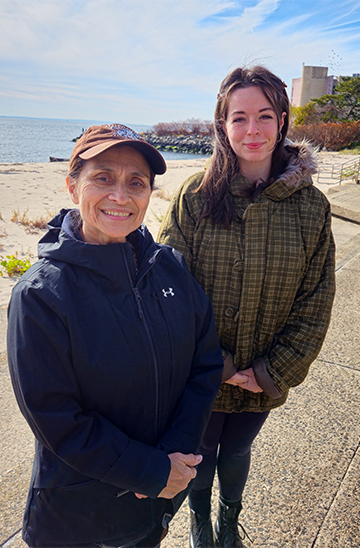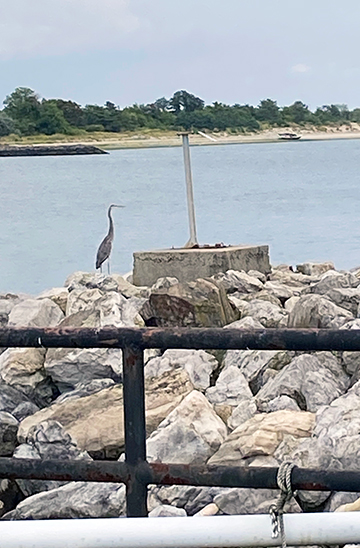Flights of Discovery: Mary Ortiz’s Biology Students

Mary Ortiz’s Biology Students Flock to Bird Research Project
Flights of Discovery: Mary Ortiz’s Biology Students Flock to Bird Research Project
If you’re like most people on campus, you’re probably aware of the gulls and geese—or at least dodged their droppings. But you might be surprised to know the campus has been visited by nearly 40 species of birds and counting—which is what students in Dr. Mary Ortiz’s comparative anatomy classes have been doing for 10 years.
Each week, the biology majors split into six groups and spend the first 15 minutes of class tracking birds along Sheepshead Bay, Jamaica Bay and the beach along the Atlantic Ocean. It’s brought a new level of awareness to the future biologists.
Ortiz, who doesn’t consider herself a birder, also became interested in birds when she started the Bird Research Project. “My mother enjoyed watching the birds in my backyard and always pointed out her favorites: the first robin of the season, cardinals (she loved red) and blue jays.”
The project idea was born after attending a conference on incorporating undergraduate research in the classroom with two colleagues and friends, Loretta Brancaccio-Taras and Sherrye Glaser. “At the conference, the idea of involving entire classes in research was discussed. I had done research with individual or small groups of students in the past, but never on a classroom scale. I also had no funding, so I started to think about how I could get my comparative anatomy class involved in a research project with meaning that would not cost anything,” she recalled. “KCC is surrounded on three sides by water. No one had ever studied the myriad birds on and around the campus, so I thought, “Why not study the birds?” It wouldn’t cost anything, and the students would get research and field experience right here on the campus.”
The students use their phones or laptops to track their findings in an Excel sheet, noting the time, week, tide, weather, what birds they’ve seen and anything interesting they might be doing. As part of their evidence, they also photograph them. “We get as close as we can to the birds without disrupting them,” shared Isabelle Caffero, balancing her laptop while taking notes on the beach. “We try to catalog each breed we see, the numbers of each and what they're up to. A lot of the time, there are some more swimming or digging around in the rocks, but the majority of the time, they're also just sleeping or sitting.”
“I was super excited when I found out we're doing this project because I love birds. It’s exciting to be able to get to hang out with my classmates and not get yelled at for being on the beach,” she quipped.
Bryonna Valero, who had an African gray when she was younger, has enjoyed seeing the differences in behavior between pet birds and those in the wild. “I didn’t really think much about average outside birds until I started observing their behaviors. Home birds are friendlier and trainable. You don’t know what you’ll get with common outside birds because each bird has its own personality."
Fanny Liang Xiao, who has had experience as a citizen scientist working with Prof. Christina Colon to monitor the movement of coyotes on Long Island, found herself more aware of the birds around her. “Now when I walk, I'm like, oh, I need to count that—even when I don't need to,” she laughed. “Before, I didn’t know the different species, but now I can recognize and name them.”
Isabelle has noticed that the birds exhibit different behavior patterns based on the tide, which that day was the lowest she’d registered all semester. “They'll get a little angsty, especially as it's gotten colder. They can be more territorial by the water when it’s low tide like this. It’s not super frequent, but the birds might fight over a spot where they were sitting or chase each other a little bit—but that could also be breeding behavior.”
She pointed out a group of black birds, which she identified as cormorants, perched on the pile moorings nearest the College’s neighbor, the Menorah Center for Rehabilitation and Nursing Care. “Before this class, I knew they’d existed, but I'd never gotten to see their full morphological characteristics in person, which was exciting.” She noted that, while the cormorants have gone from rare to prevalent on the beaches over the past few years, there has been a downtrend in their presence over the past few weeks. “Normally, we've been seeing an average of over 20 VP, but for the past three weeks, it's gone down to sub-20, with the majority of them hanging out over there.”
While the casual observer can correctly conclude that gulls are prevalent on campus, these biology students can now distinguish which species are most common. They include the herring, ring-billed, black-backed and Thayer’s gulls. “Each gull has distinctive markings, though some can be difficult to differentiate because they can be quite similar in appearance. It takes time and experience to tell them apart, especially the juveniles,” explained Ortiz.
Other common species of birds observed include Canada and Brant geese, rock pigeons, mute swans, ducks, and, of course, cormorants. They are part of the influx of birds coming to nest on campus post-Sandy in 2012, when the dunes in Rockaway were destroyed.
Along the Jamaica Bay seawall, Fanny spotted a laughing gull, which has a distinctive black head and red beak—and does indeed sound like it’s laughing.
There were two surprise visitors this semester: A blue heron, which had never been identified by previous classes, and a hawk. “We’d questioned whether the student had correctly identified the blue heron, but she was able to produce her proof—a photo she’d taken as part of her documentation—and sure enough! It was a blue heron,” said Ortiz.
While the three biology students have different goals in mind—Isabelle plans to study marine biology; Bryonna is hoping to work in equine studies, rehabilitating and rehoming horses; and Fanny, medical laboratory sciences—they'll all benefit from skills learned via birding.
“As citizen scientists, they are “doing” real science and gaining research and field experience,” said Ortiz, a biomedical engineer by training. “The students are learning how to gather and analyze data, use their observation skills to identify and catalog birds, and write up a lab report and present their findings.”
“They are also learning that there are obstacles to doing research, such as having difficulty identifying birds in flight that are not stationary,” she added.
In addition to learning about birds and how to identify them, Ortiz hopes that her students will appreciate birds more, have a bona fide opportunity to be a scientist taking part in field experience and conducting actual research, and enjoy the sheer beauty and elegance of birds as they learn.
“This project taught me that birding doesn't have to be done in some remote location or deep in a park. It can be accomplished anywhere you're willing to take a moment and observe,” offered Isabelle. “There are so many fascinating species of urban birds that don't get the respect or credit they deserve. I feel that this project has helped to educate not only me but the rest of my group about the beauty and brilliance of these creatures. I hope that this project has inspired other students to feel similarly and continue birding in the future.”

Biology professor, Dr. Mary Ortiz, and biology major Isabelle Caffero on the KCC beach.

Image of the blue heron, which visited the campus this past September, taken by biology major Crystal Fahrer
About Ovations
KCC's faculty are exemplary professors, researchers, authors and more. Through Ovations,
we seek to spotlight the extraordinary work, distinctive achievements and unique endeavors
of Kingsborough's faculty members by highlighting their excellence in teaching, research
and service.
Recent Articles
- Tyronne Johnson Named to NYAST Board of Directors
- Dr. Kwesi W. Blackman ’07 Elected Chair of KCC Foundation Board
- The Aspen Institute Names KCC a Top 200 U.S. Community College Eligible for the 2027 Aspen Prize
- Wave Capture First NYC Soccer Community College Championship
- NEH Awards $200K to KCC Professor
- Inspiring Next-Gen Scientists
- 28 New Doulas Graduate at Kingsborough
